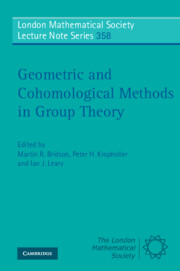Book contents
- Frontmatter
- Contents
- Preface
- List of Participants
- Notes on Sela's work: Limit groups and Makanin-Razborov diagrams
- Solutions to Bestvina & Feighn's exercises on limit groups
- L2-Invariants from the algebraic point of view
- Constructing non-positively curved spaces and groups
- Homology and dynamics in quasi-isometric rigidity of once-punctured mapping class groups
- Hattori-Stallings trace and Euler characteristics for groups
- Groups of small homological dimension and the Atiyah conjecture
- Logarithms and assembly maps on Kn(Zl[G])
- On complete resolutions
- Structure theory for branch groups
Hattori-Stallings trace and Euler characteristics for groups
Published online by Cambridge University Press: 07 September 2011
- Frontmatter
- Contents
- Preface
- List of Participants
- Notes on Sela's work: Limit groups and Makanin-Razborov diagrams
- Solutions to Bestvina & Feighn's exercises on limit groups
- L2-Invariants from the algebraic point of view
- Constructing non-positively curved spaces and groups
- Homology and dynamics in quasi-isometric rigidity of once-punctured mapping class groups
- Hattori-Stallings trace and Euler characteristics for groups
- Groups of small homological dimension and the Atiyah conjecture
- Logarithms and assembly maps on Kn(Zl[G])
- On complete resolutions
- Structure theory for branch groups
Summary
Introduction
For G a group and P a finitely generated projective module over the integral group ring, Bass conjectured in [2] that the Hattori-Stallings rank of P should vanish on elements different from 1 ∈ G, and proved it in many cases such as torsion-free linear groups. Later, this conjecture has been proved for many more groups, notably by Eckmann [13], Emmanouil [15] and Linnell [22]. The latest advances are given in [3] and the first section of the present paper is a quick survey of the Bass conjecture, together with an outline of the proof of the main result of [3].
In most cases, one proves a stronger conjecture, which asserts that the Hattori-Stallings rank of a finitely generated projective module over the complex group ring should vanish on elements of infinite order (that this conjecture is indeed stronger follows from Linnell's work [22]). Given a group G of type FP over ℂ, its complete Euler characteristic E(G) is the Hattori Stallings rank of an alternating sum of finitely generated projective modules over ℂG, and on the elements of finite order, one could then ask of what the values do depend. It is Brown in [7] who first studied that question, proving a formula in many cases. In Section 2 we shall explain the basics to understand Brown's formula and propose Conjecture 1 below as a generalization. Our generalization amounts to putting Brown's work in the context of L2-homology (not available at the time when [7] was written), and applies to cases where Brown's formula is not available.
- Type
- Chapter
- Information
- Geometric and Cohomological Methods in Group Theory , pp. 256 - 271Publisher: Cambridge University PressPrint publication year: 2009
- 2
- Cited by

